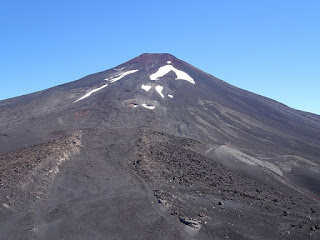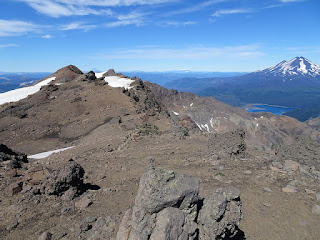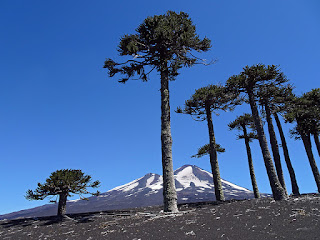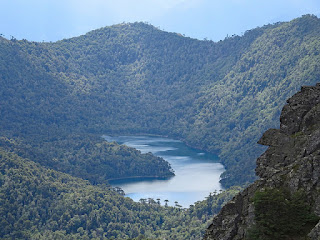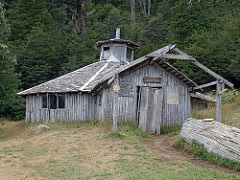Easy Mountaineering in the Argentine and Chilean Atacama
This trip to the Puna de Atacama was organised and led by John Biggar. We started and ended in Copiapo (in Chile), from where we hired a 4x4 from Europcar. The first part of the trip was based around Antofagasta de la Sierra (in Catamarca Province, Argentina). We then re-crossed the Paso de San Francisco, heading back into Chile, to climb Ojos del Salado.
Links to Photographs from this Trip
Cerro Miriguaca
Cerro Miriguaca is a peak of around 4740 m that is easily accessible from Antofagasta de la Sierra (in Catamarca Province, Argentina) and a useful acclimatization hike. The summit gives good views over the surrounding landscape.
 |
| Cerro Miriguaca (left-of-centre on the skyline) |
The ascent of this peak is quite a simple hike across slopes covered by tufty ichu grass. We left our vehicle at (3751 m, lat. -25.97441°, long. -67.33219°) and, after crossing the small gully, headed up the hillsides in a northeasterly direction. Our route is indicated by the waypoints given below.
 |
| Summit View from Cerro Miriguaca |
Key Waypoints (latitude/°, longitude/°, elevation/m)
-25.96144 , -67.31422 , 3967
-25.96142 , -67.31424 , 3966
-25.95669 , -67.30398 , 4316
-25.95396 , -67.29126 , 4534
-25.94921 , -67.28718 , 4665
-25.95160 , -67.28519 , 4743 Summit
Laguna Blanca Sur
Laguna Blanca Sur (not an official name) is a peak of around 5930 m elevation at the southern end of the Sierra Laguna Blanca, in the Catamarca Province of Argentina. It is clearly visible from the highway (Ruta 43) leading from Belen to Antofagasta de la Sierra.
 |
| Laguna Blanca Sur |
Approach to High Camp
A track leads from the main highway at (lat. -26.73053°, long. -67.03138°) and heads towards the foot of the mountain. We left our vehicle at (lat. -26.70545°, long. -67.04548°) at ca. 3880 m. Although the track continues for several kilometres beyond this point, there is a steep slope, comprised of loose sand, that you would need to be confident of being able to ascend upon your return. Follow the track as far as the animal corral at (lat. -26.66377°, long. -67.04176°) at ca. 4080 m. Shortly thereafter you should cross the stream and then make your way up the right-bank (when looking uphill). Further up the valley splits (photo) and you should head up to the right so as to enter the righthand branch of the valley. The location of our highcamp (photo) was (4704 m, lat. -26.61776°, long. -67.03821°), limited to this rather low altitude by the availability of water.
Route Schematic (click on image to see an enlarged version; then close the image using the button in the top-right corner to return to this page)
From high camp there are two possible routes to the summit (see the schematic below):
Option 1 (red dots - the route we followed)
Follow the valley from the camp up to the obvious col at the head of the valley (5122 m, lat. -26.59986°, long. -67.03848°). At the col bear sharply left and begin the climb up the loose rocky slope of the southeast ridge of the mountain.
Option 2 (purple dots - untested, but possibly simpler)
From the high camp, head up the slope on the western side and make your way up onto the foot of the south ridge of the mountain (around lat. -26.61965°, long. -67.04229°). Then make your way straight up the south ridge (photo).
Route Schematic (click on image to see an enlarged version; then close the image using the button in the top-right corner to return to this page)
 |
| Summit view from Laguna Blanca Sur |
Key Waypoints (latitude/°, longitude/°, elevation/m) - via Option 1
-26.59986 , -67.03848 , 5122 Col
-26.59698 , -67.04615 , 5301
-26.59976 , -67.04886 , 5372
-26.59737 , -67.05167 , 5456
-26.59453 , -67.05430 , 5679
-26.59199 , -67.05513 , 5744
-26.58587 , -67.06019 , 5903
-26.58404 , -67.06100 , 5935 Summit
Cerro Laguna Blanca
Cerro Laguna Blanca is a peak of just over 6000 m in the centre of the Sierra Blanca, in the Catamarca Province of Argentina.
 |
| Sierra Laguna Blanca (Co. Laguna Blanca is behind this ridge) |
Approach to High Camp
From the road just south of El Penon, drive across the flood plain leading up to the foothills (following various ill-defined vehicle tracks) to around 4200 m - we “parked” our vehicle at (lat. -26.54702°, long. -67.15883°).
From this point you head towards the point where a small valley emerges from the hills (photo). A stream descends this valley. Follow the bed of the stream up the valley, which becomes progressively narrower. At one point you have to scramble up beside a small waterfall (photo), or you can climb up the righthand hillside to skirt around this obstacle. This route is marked by red-dots on the schematic below.
The location of our highcamp (photo) was (4911 m, lat. -26.57046°, long. -67.10728°), at the side of a broad floodplain, although a higher camp may be possible (and preferable) if there is running water above this point in the valley.
An alternative route to highcamp: rather than following the stream bed it is possible to make your way up the lefthand hillside towards a col which is visible on the skyline (photo - with col indicated). From the col (4980 m, lat. -26.56555°, long. -67.11160°) you look out over the floodplain (photo) and it is an easy descent to the campsite. This route would be preferred to the normal route if the stream level is high, or if you are accompanied by animals. It is marked by purple-dots on the schematic below.
Route Schematic (click on image to see an enlarged version; then close the image using the button in the top-right corner to return to this page)
High Camp to the Summit
Head eastwards up the valley (photo), which narrows before turning sharply to the left. Continue climbing up the valley, which now heads in a northerly direction. The summit ridge of the Sierra Laguna Blanca runs parallel to the valley on the righthand (eastern) side. There are two obvious easy routes up the slopes to this ridge. The first way (the route we took) starts at around 5531 m (lat. -26.54849°, long. -67.07424°) and leads up to the ridge just before (on the southern side of) the “south summit”. The second starts at around 5610 m (lat. -26.53733°, long. -67.07193°) and leads up to reach the ridge between the true summit and the “south summit”.
Route Schematics (click on image to see an enlarged version; then close the image using the button in the top-right corner to return to this page)
Overview of route
Approaching the summit
Where exactly is the summit?
Cerro Laguna Blanca is part of an extended ridge (running north-south) which has a number of high points. There is a minor summit of just under 6000 m, the “south summit”, with a large stone platform (presumably of Inca-origin) and a stone wind-break, at (5992 m, lat. -26.54241°, long. -67.06238°). However, the true summit (with an elevation of over 6000 m) lies north of this, on a gently undulating plateau. The exact location of the true summit is not immediately obvious. The summit we reached was located at (6009 m, lat. -26.53388°, long. -67.06114°), but there is another point of similar height lying slightly further to the north.
 |
| Summit panorama from Cerro Laguna Blanca |
Key Waypoints (latitude/°, longitude/°, elevation/m) - via Option 1
-26.56976 , -67.09320 , 5065
-26.56814 , -67.08534 , 5166
-26.56080 , -67.07953 , 5316
-26.54849 , -67.07424 , 5531
-26.54923 , -67.06842 , 5683
-26.54744 , -67.05994 , 5899
-26.53654 , -67.05964 , 5986
-26.53388 , -67.06114 , 6009 Summit (?)
Ojos del Salado
Ojos del Salado is the second highest peak in South America and the highest volcano in the world. It has two summits (which are closely-spaced and of virtually the same elevation) – these are commonly referred to as the Chilean summit and Argentinian summit.
 |
| View of Ojos del Salado (from the Chilean side) |
We approached the mountain from the Chilean side, which is quicker and logistically simpler, since there is a driveable track up to high elevations on this side of the mountain. There are also two "refuges" (simple converted shipping containers) – the Atacama Refuge (Refugio Universidad de Atacama) at around 5200 m and the Refugio Tejos at 5830 m. When we climbed the peak (in late March 2016) there was very little snow on the mountain and crampons/ice axes were not required.
Important - because it is easy to access, this mountain could easily be underestimated. By any measure this is a seriously high mountain and appropriate acclimatization to altitude is essential. We were lucky with the weather, but the mountain is prone to high winds and very low temperatures, so appropriate cold-weather gear is also essential.
Refugio Tejos to the Crater
From the Refugio Tejos there is a clear trail which zig-zags up a pale-coloured shale slope, before crossing a small patch of snow and then “traversing” around to the right to access the small crater below the summit.
Click on the diagram to enlarge ...
In the absence of snow and ice, this section of the climb is no more than a very high altitude hike, with no technical difficulties. As you gain altitude the views over the surrounding landscape get better and better ....
 |
| Panorama from the crater of Ojos del Salado, at around 6740 m |
Crater to the Summit
The view of the summit when you get to the crater is shown below. From the floor of the crater to the summit is a further climb of around 150 m.
 |
| Summit of Ojos del Salado |
A path (visible on the above photograph) skirts around the lefthand side of the crater and then climbs up through the boulders on the far side. The route to the Chilean summit is up a gully (photo) that is located towards the righthand side of the headwall.
At the top of this gully is a short technical section. The fixed rope that was installed several years ago is no longer fit for purpose, and John Biggar led this part of the climb for our group and installed protection for the rest of us. We also abseiled down this section on the return, rather than back-climbing the route.
 |
| Scramble up to the Chilean Summit |
Once up this section, there is a very short walk along the ridge to the summit.
The view from the summit are spectacular and an appropriate reward for the hard effort expended in getting there ....
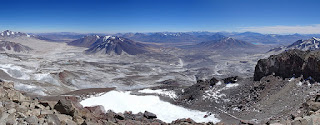 |
| Summit Panorama 1 |
 |
| Summit Panorama 2 |
 |
| Summit Panorama 3 |
How high is Ojos del Salado ?
The elevation of the summit is most commonly given as 6893 m - my own GPS units (a Garmin eTrex10 and that built into the Sony HX90 camera) gave readings of 6903-6905 m based on the WGS84 datum.






